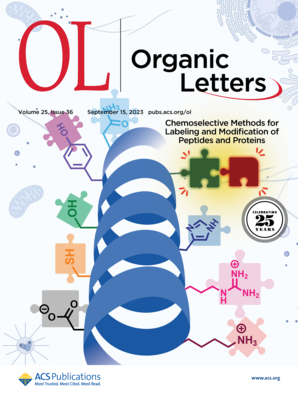序序去质子化促进炔和醛的多取代呋喃及其低聚芳基的快速和可控组装
IF 5
1区 化学
Q1 CHEMISTRY, ORGANIC
引用次数: 0
摘要
提出了一种新的二甲基亚砜(DMSO)和丙炔醇在碱存在下的顺序去质子化策略,用于生成α-羟基碳离子,该策略可以在过渡金属和无添加剂的条件下,从炔和醛在一个锅中快速可控地获得多种有价值的高功能化呋喃。初步的机制研究揭示了碱基和二甲基亚砜的关键作用。更重要的是,氘标记实验证实了α-羟基碳离子的形成。本文章由计算机程序翻译,如有差异,请以英文原文为准。

Rapid and Controlled Assembly of Polysubstituted Furans and Their Oligoaryls from Alkynes and Aldehydes Facilitated by Sequential Deprotonation
A new sequential deprotonation strategy of dimethyl sulfoxide (DMSO) and propargyl alcohol in the presence of a base was developed for the generation of the α-hydroxyl carbanion, which enables rapid and controllable access to a wide range of valuable highly functionalized furans in one pot from alkynes and aldehydes under transition-metal- and additive-free conditions. Preliminary mechanistic studies revealed the crucial role of the base and DMSO. More importantly, deuterium labeling experiments confirmed the formation of the α-hydroxyl carbanion.
求助全文
通过发布文献求助,成功后即可免费获取论文全文。
去求助
来源期刊

Organic Letters
化学-有机化学
CiteScore
9.30
自引率
11.50%
发文量
1607
审稿时长
1.5 months
期刊介绍:
Organic Letters invites original reports of fundamental research in all branches of the theory and practice of organic, physical organic, organometallic,medicinal, and bioorganic chemistry. Organic Letters provides rapid disclosure of the key elements of significant studies that are of interest to a large portion of the organic community. In selecting manuscripts for publication, the Editors place emphasis on the originality, quality and wide interest of the work. Authors should provide enough background information to place the new disclosure in context and to justify the rapid publication format. Back-to-back Letters will be considered. Full details should be reserved for an Article, which should appear in due course.
 求助内容:
求助内容: 应助结果提醒方式:
应助结果提醒方式:


